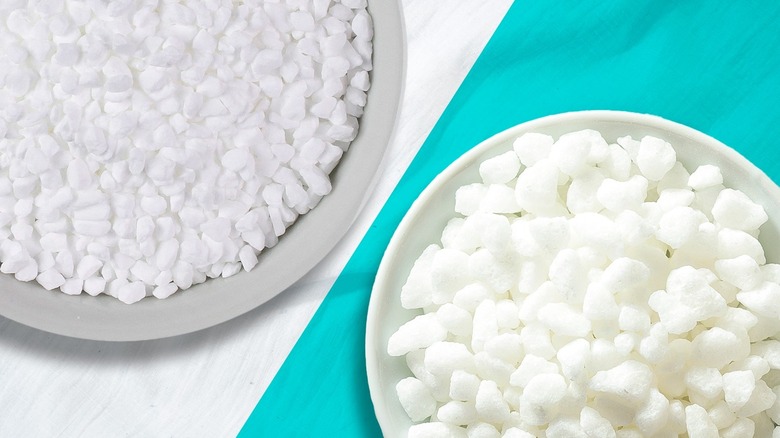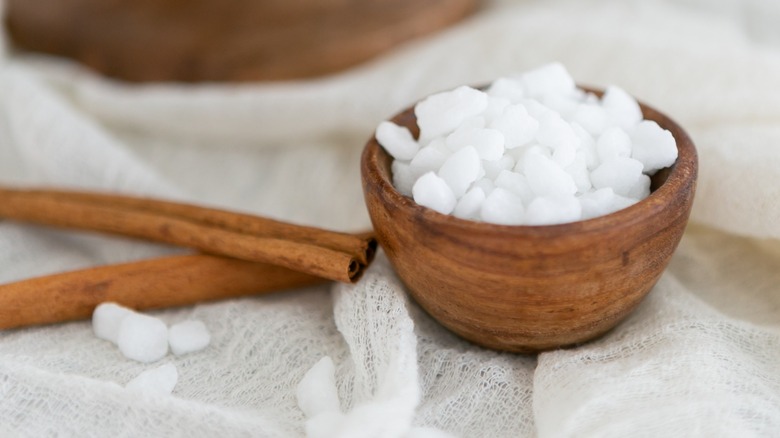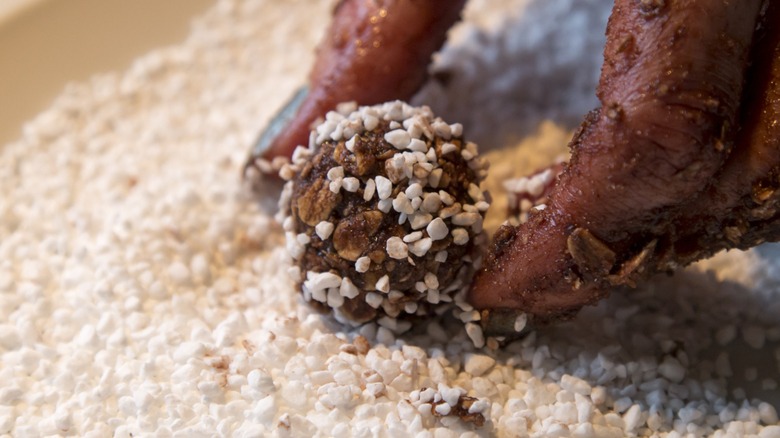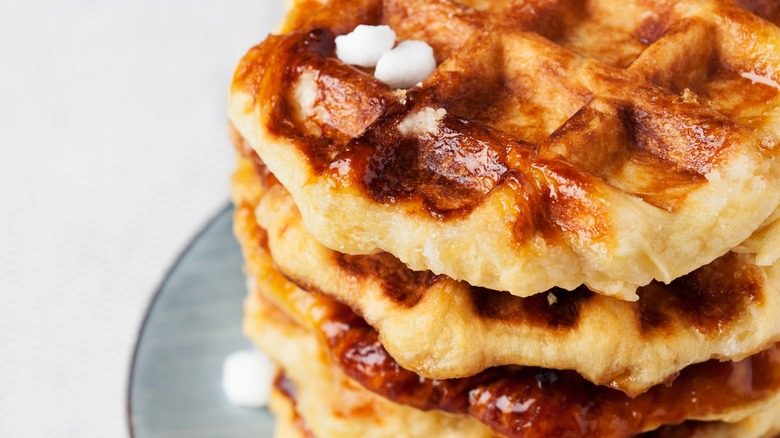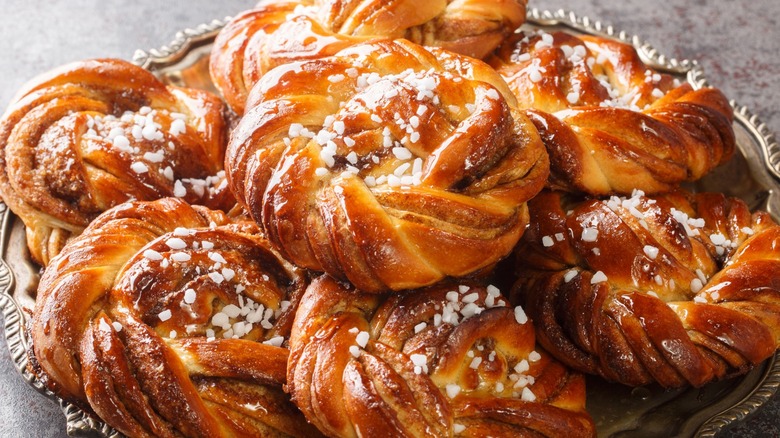Belgian Pearl Sugar Vs Swedish: What's The Difference?
The name "pearl sugar" might conjure up images of those perfectly round, sometimes pearlescent, sprinkles seen on cookies and cakes. The confusion is understandable: those are sugar pearls, not pearl sugar. Rough and irregular, pearl sugar looks more like lumpy, bumpy freshwater pearls than the kind you'd find at Tiffany's. Sometimes known as "nib sugar," it has more in common with sugar cubes than birthday cake sprinkles.
Unlike regular sugar, pearl sugar won't melt away under high heat. Since it holds its shape, it's typically used to add texture to baked goods, either as a topping or mixed into the batter or dough. Pearl sugar is popular throughout Europe, but it's best known in Belgium and Sweden. Both countries have their own namesake varieties: Belgian pearl sugar and Swedish pearl sugar. But how different can rough little lumps of sugar really be? Surprisingly different.
Despite their similarities, the two ingredients are subtly distinct in ways that can have a big impact. Belgian pearl sugar is bigger — sometimes reaching the size of a peanut — and is more condensed. Swedish pearl sugar, meanwhile, is smaller and lighter. While the two generally have different uses, they can also be used interchangeably. However, it's important to know the differences between these two types of sugar before substituting one for the other.
What is Belgian pearl sugar?
Belgian pearl sugar is large, tightly packed, and crunchy. It's meant to be mixed into batters and doughs. When baked, it caramelizes to form sweet, crunchy pockets. It's a key ingredient in one of the country's most famous — and beloved — cultural exports: Belgian waffles. If you've only had the type of "Belgian waffles" served at hotel breakfast buffets, you might not be familiar with the crunchy texture of the real deal.
That authentic crunch comes from caramelized pearl sugar. Belgian pearl sugar is typically made from sugar beets rather than sugar cane. Beet sugar isn't that different from cane sugar, but it does have a slightly earthier taste and isn't quite as sweet. It also melts differently, a key consideration if you're trying to make truly authentic Belgian waffles.
There are two main producers of Belgian pearl sugar: Couplet and Tirlemont. The two producers use different methods, which makes for two different products. Couplet is generally the preferred brand: its pearls are packed densely, making them less likely to melt away into the dough. Couplet pearls are also less sticky, which makes for easier cleanup. That's a pretty big bonus — there are few substances more stubborn than melted sugar.
What is Swedish pearl sugar?
Have you ever seen a croissant, Danish, or panettone decked with what appears to be sea salt? Chances are, that "salt" is actually Swedish pearl sugar. Smaller than its Belgian counterpart, Swedish pearl sugar is typically used as a topping or decoration — think of it as an old-fashioned sprinkle. You won't find it baked into recipes — it'll disappear into the batter. Traditionally, the uses for Belgian pearl sugar are pretty limited. Belgian waffles, cramiques, and Dutch suikerbrood are its main claims to fame.
Swedish pearl sugar, on the other hand, is more versatile and enjoys wider popularity. Of course, it's used in traditional Swedish sweets like chokladbollar, but it's popular in other cuisines across Europe, too. In France, Swedish pearl sugar is used to top sweet choux pastry puffs called chouquettes; in Germany, it's liberally doused on saure-sahne-plätzchen, or sour cream cookies. Swedish pearl sugar also often makes an appearance on Finnish pulla, a sweet cardamom bread served in braided loaves.
Swedish pearl sugar tends to come from sugar cane, the source of 70% of the world's sugar. There isn't a significant nutritional difference between beet sugar and cane sugar, but there is a difference in the way that they're processed. Cane sugar is often refined using bone char, an animal byproduct. Some vegans and vegetarians avoid it in favor of beet sugar, which isn't processed with animal products.
Belgian pearl sugar is baked into waffles and breads
Too big to be used as a garnish, Belgian pearl sugar is best known for one thing: making Belgian waffles. Genuine Belgian waffles — also called Liège waffles — boast small, crunchy pockets of caramelized sugar embedded in the batter. These pockets are formed when lumps of pearl sugar caramelize and brown against the heat of the waffle iron, and they're part of what makes authentic Belgian waffles unique.
Belgian pearl sugar isn't just used for waffles, though. It's sometimes used in lieu of — or in addition to — raisins in cramiques, a type of Belgian brioche. It's also used in Dutch sugar bread, known as suikerbrood. Suikerbrood, a simple yeasted bread typically baked in a roll, sometimes incorporates cinnamon along with lumps of pearl sugar. If you want to try working with Belgian pearl sugar, make a few batches of Belgian waffles or brioche buns — then consider experimenting to develop your own recipes.
Swedish pearl sugar is better as a topping
While Belgian pearl sugar is meant to melt and caramelize into batters and doughs, its Swedish cousin is typically used as decoration on top of buns, cookies, and other baked goods. Like most garnishes, toppings, and decorations, Swedish pearl sugar might seem like an optional add-on. If you're just using it as a finishing touch on cookies or kardemummabullar — Swedish cardamom buns — it's okay to forgo it if you want. However, Swedish pearl sugar adds an essential textural element to some sweets.
Chokladbollar, or traditional Swedish chocolate balls, are encrusted with pearl sugar for an extra crunch. Without pearl sugar, chouquettes would just be plain balls of choux. Even when pearl sugar doesn't play an essential role in the recipe, it adds an extra air of authenticity to many Nordic sweets. If you can stand the extra expense (and aren't trying to keep an eye on your sugar consumption), it's worthwhile to buy some pearl sugar as an elegant way to dress up your confections.
